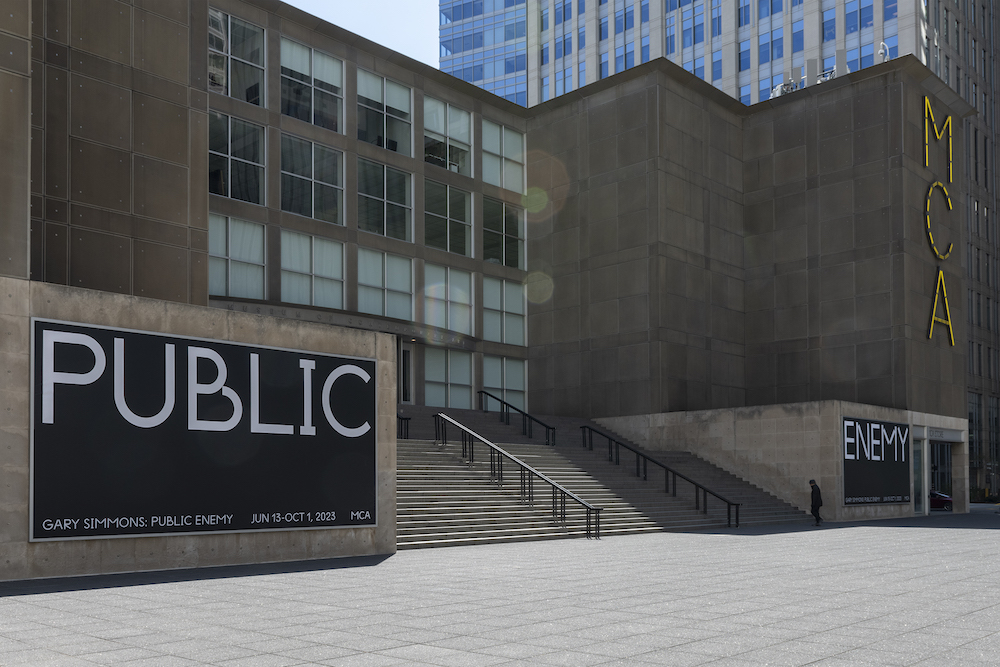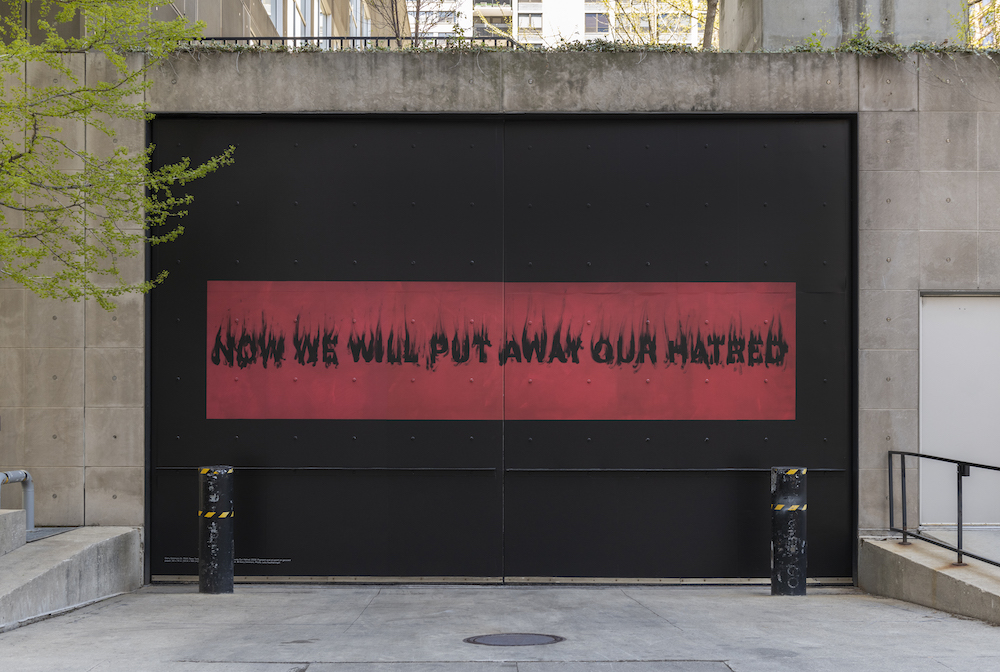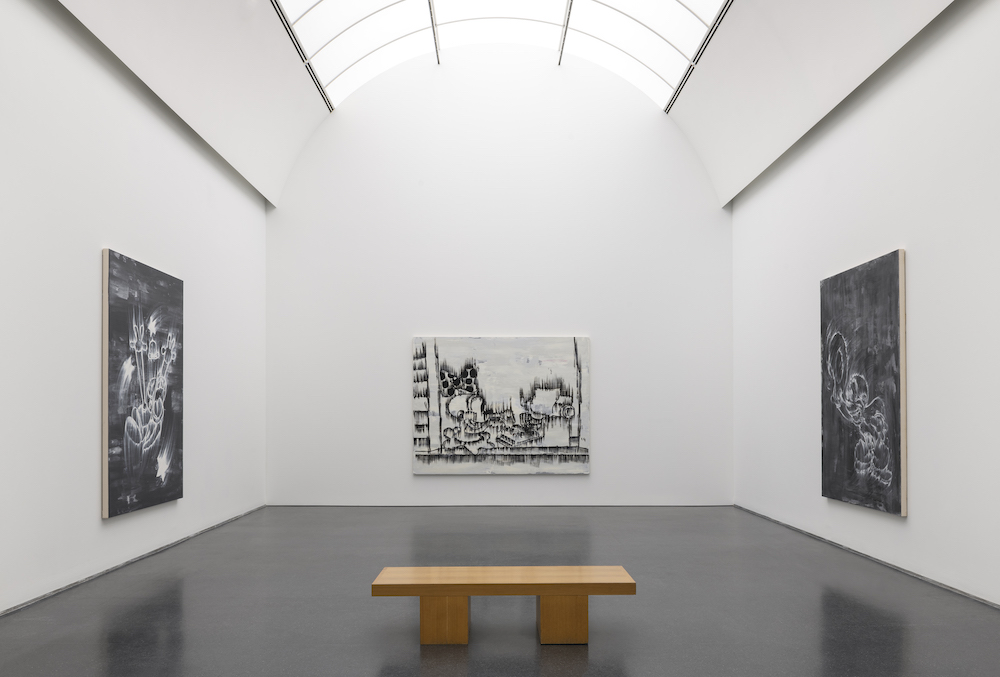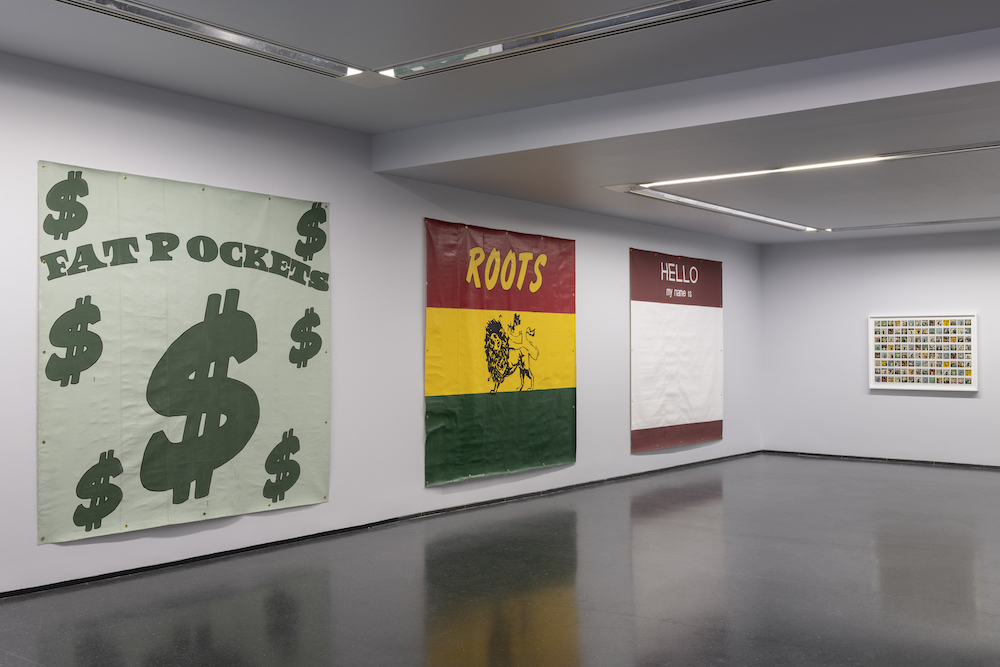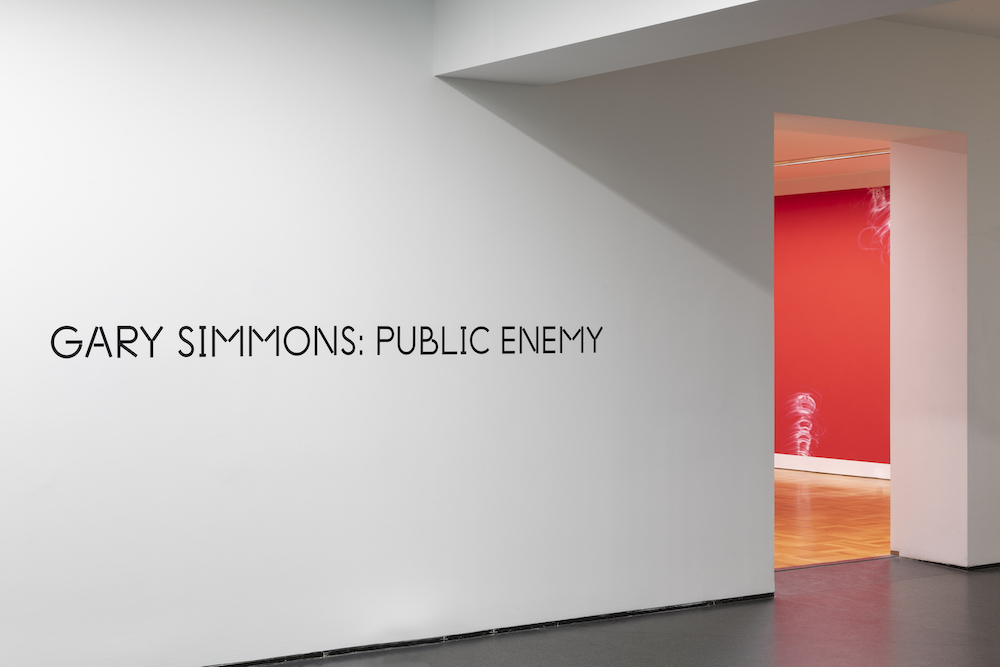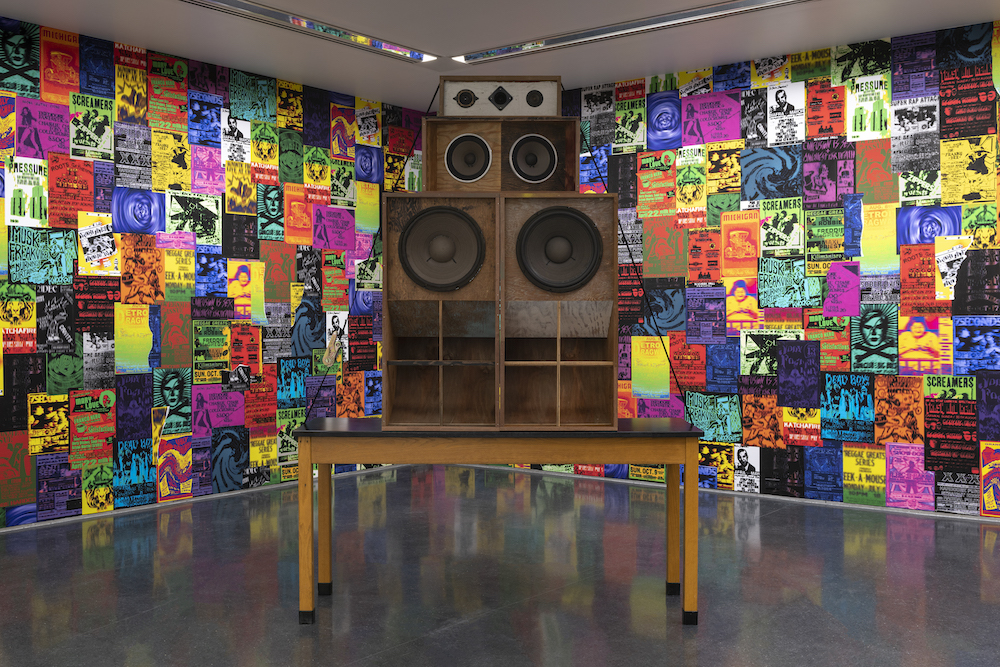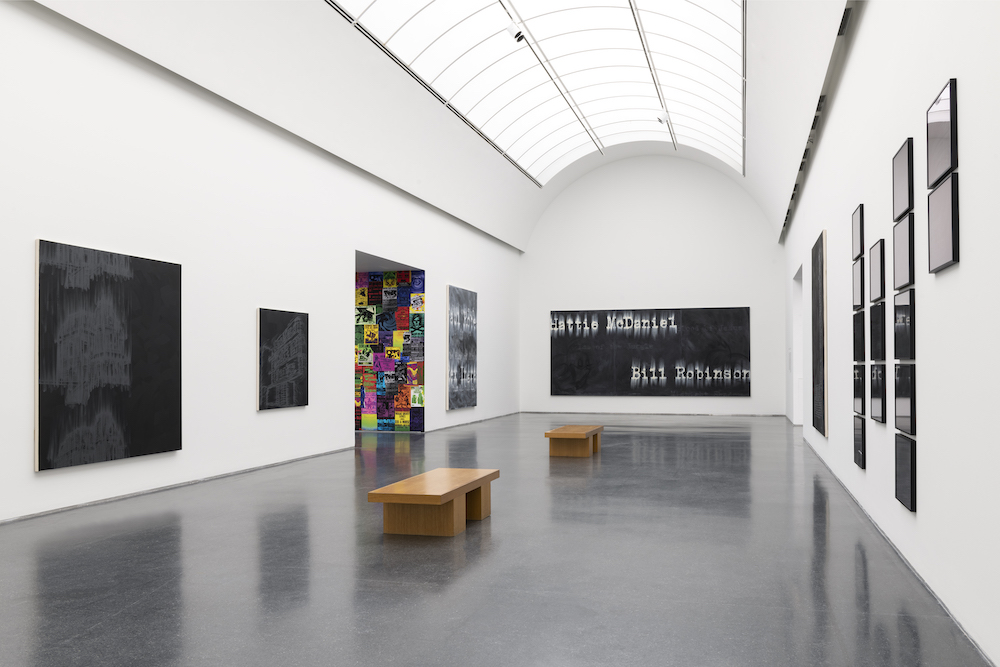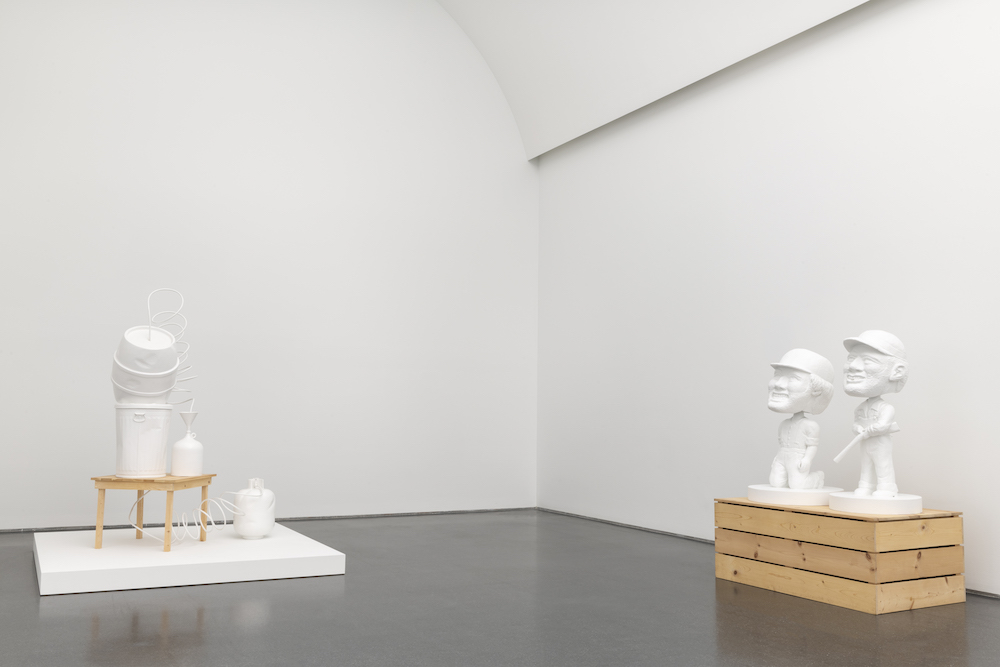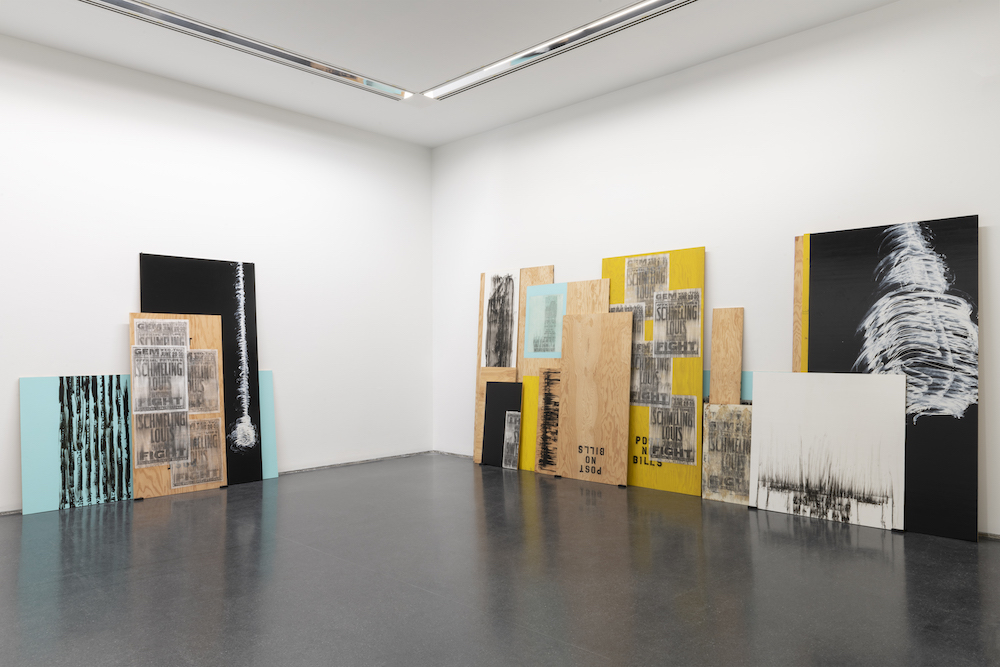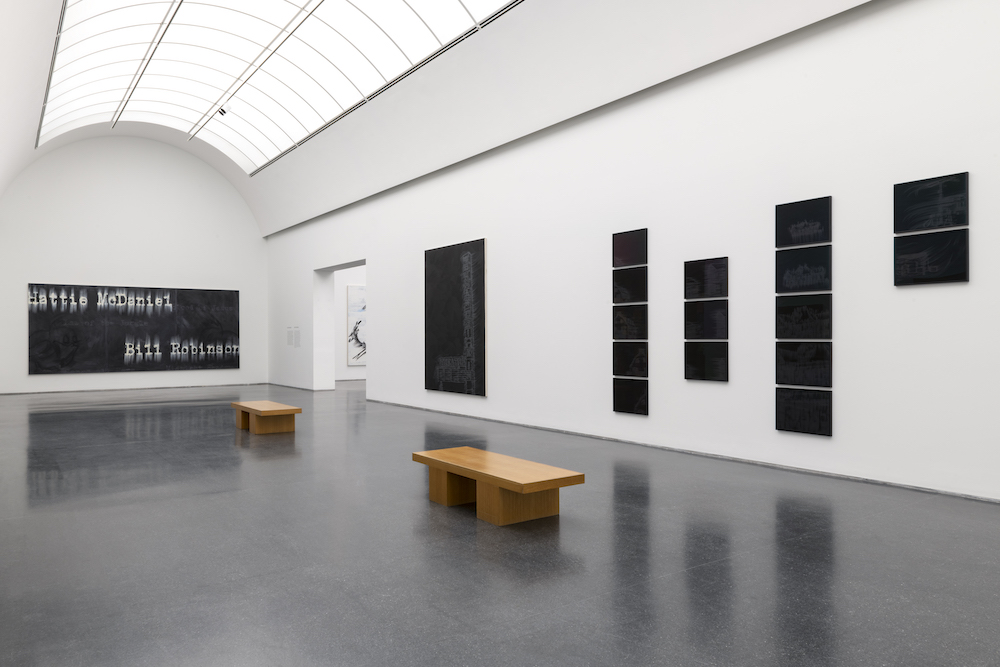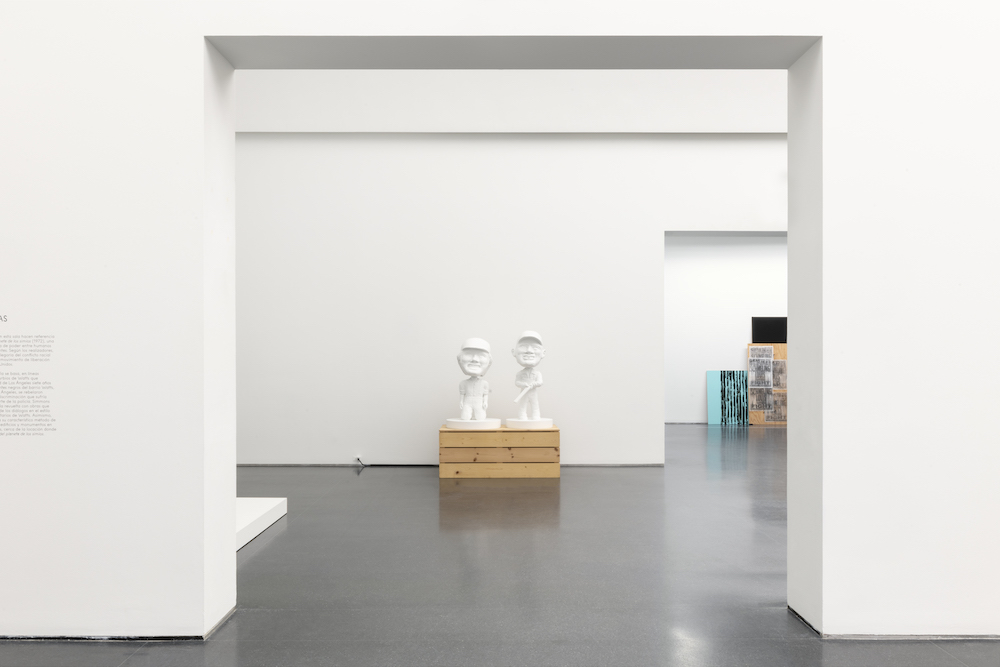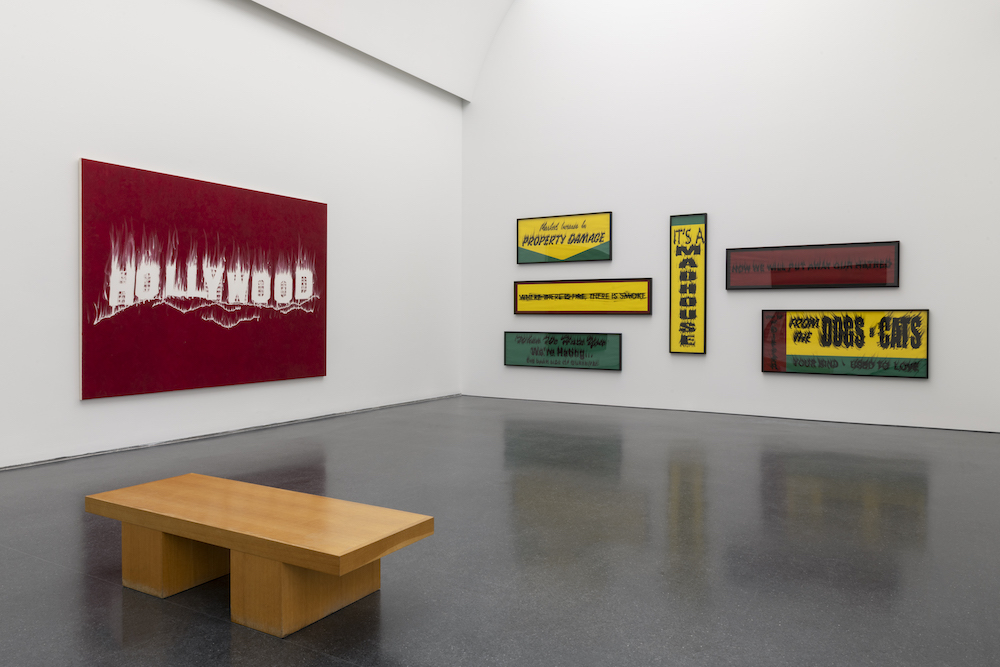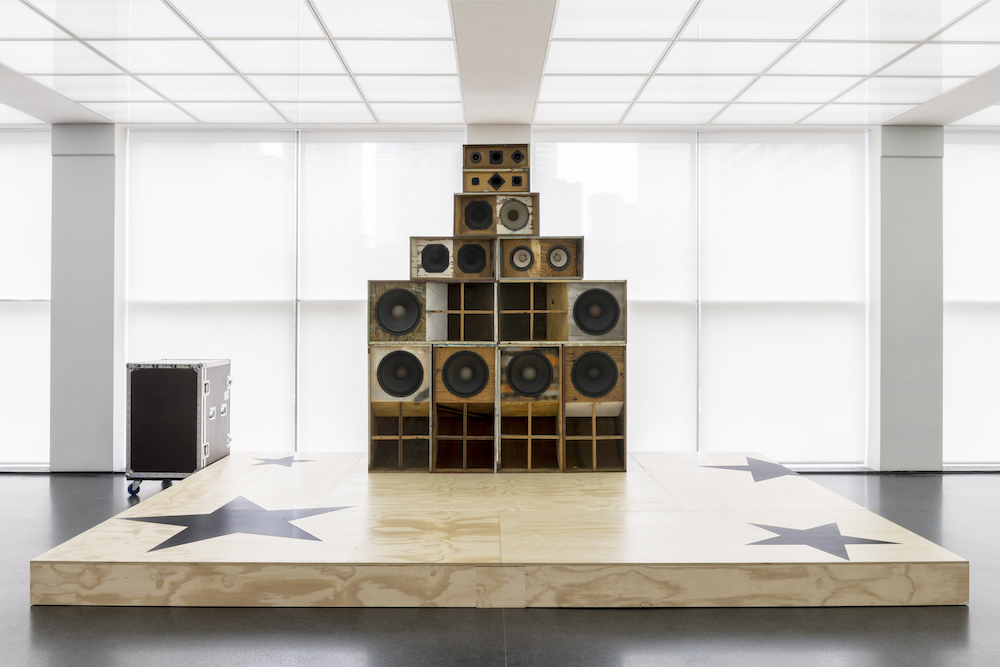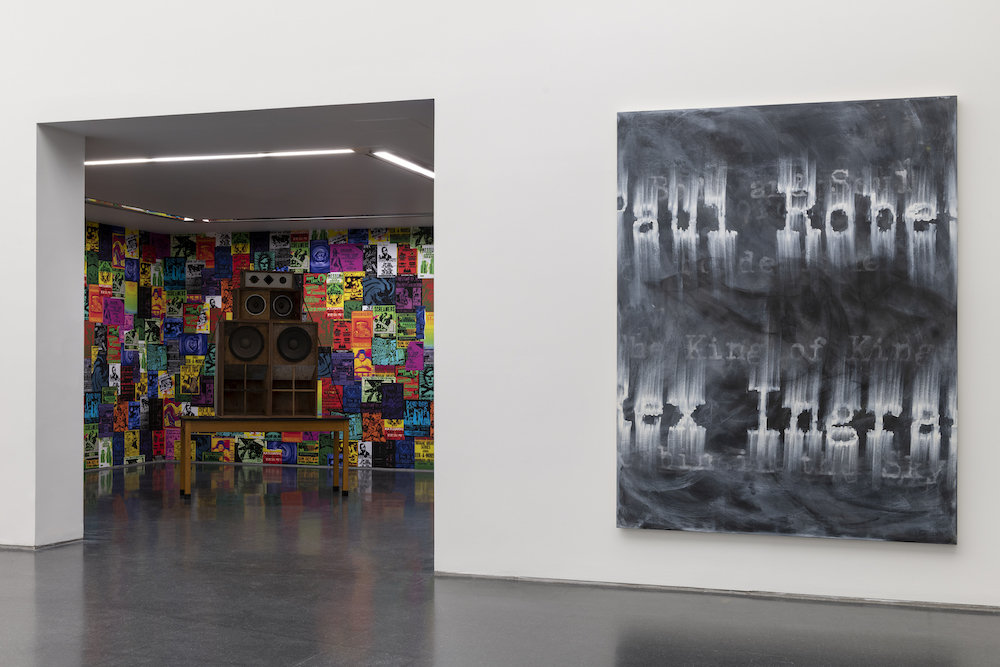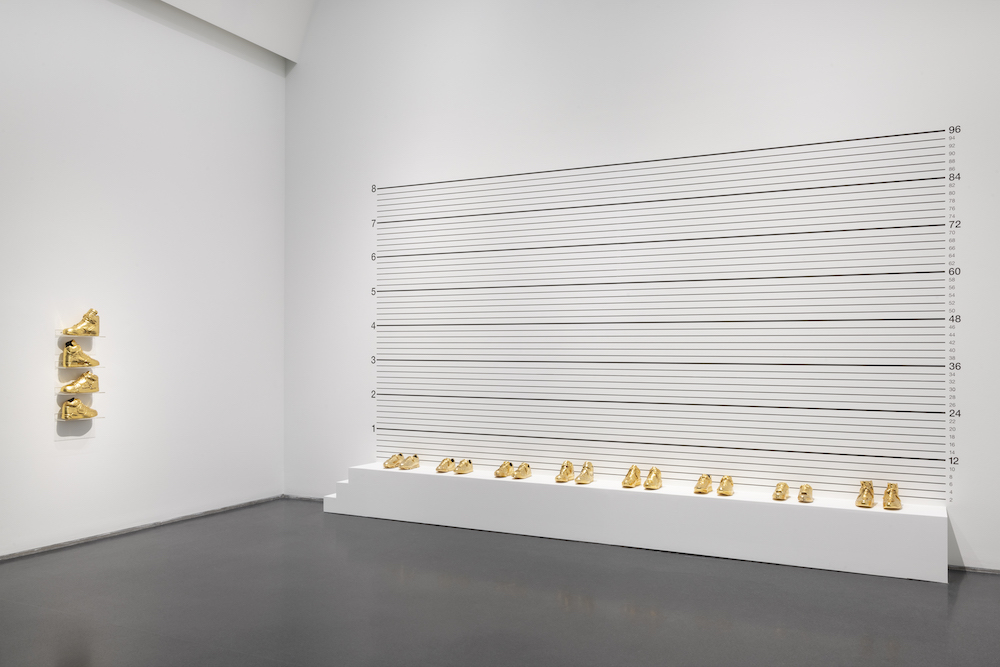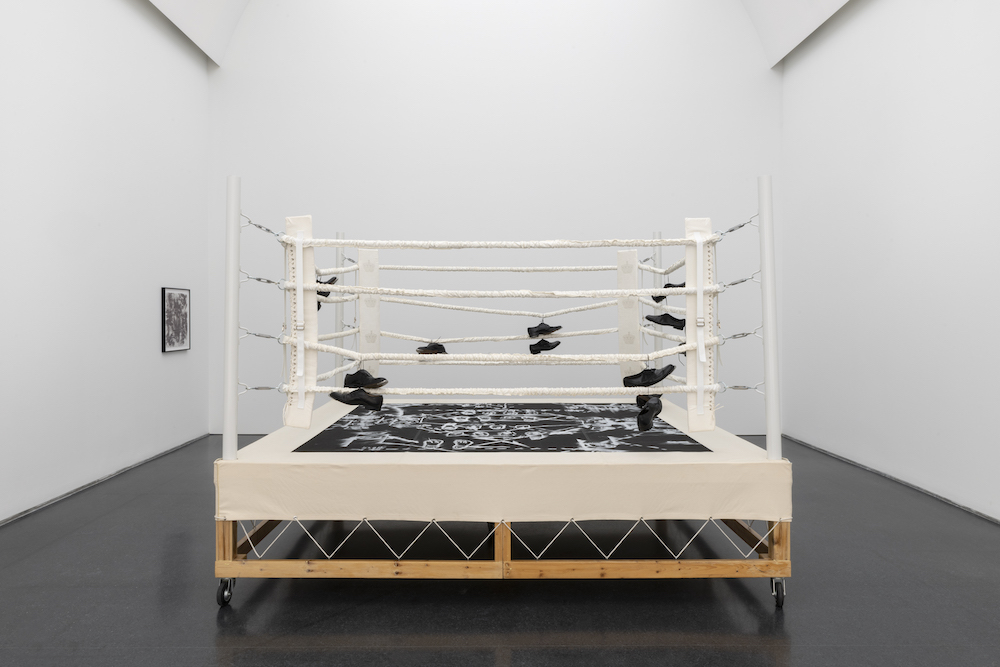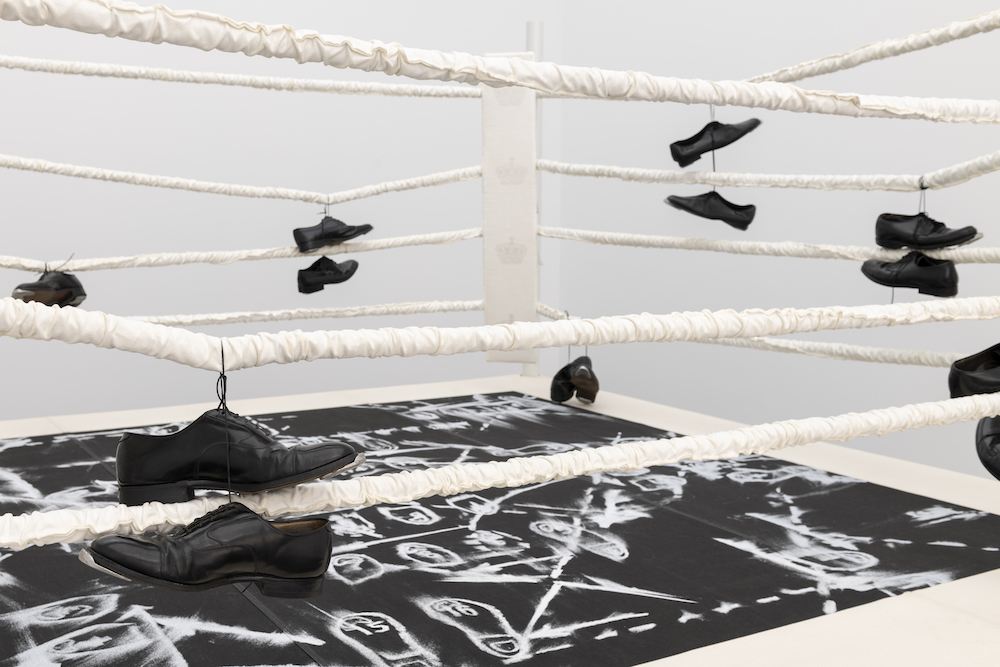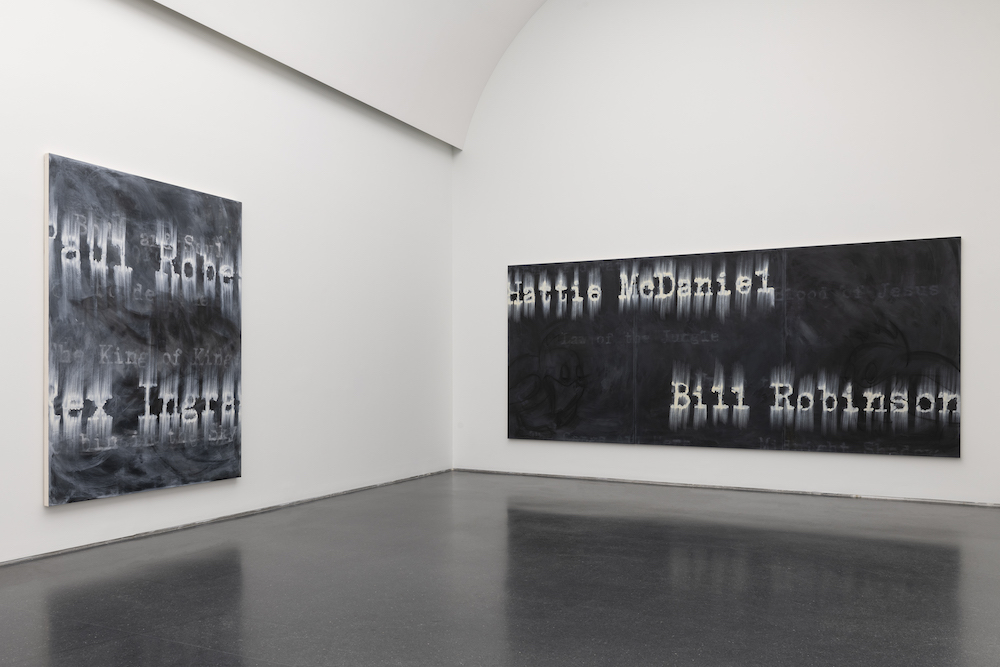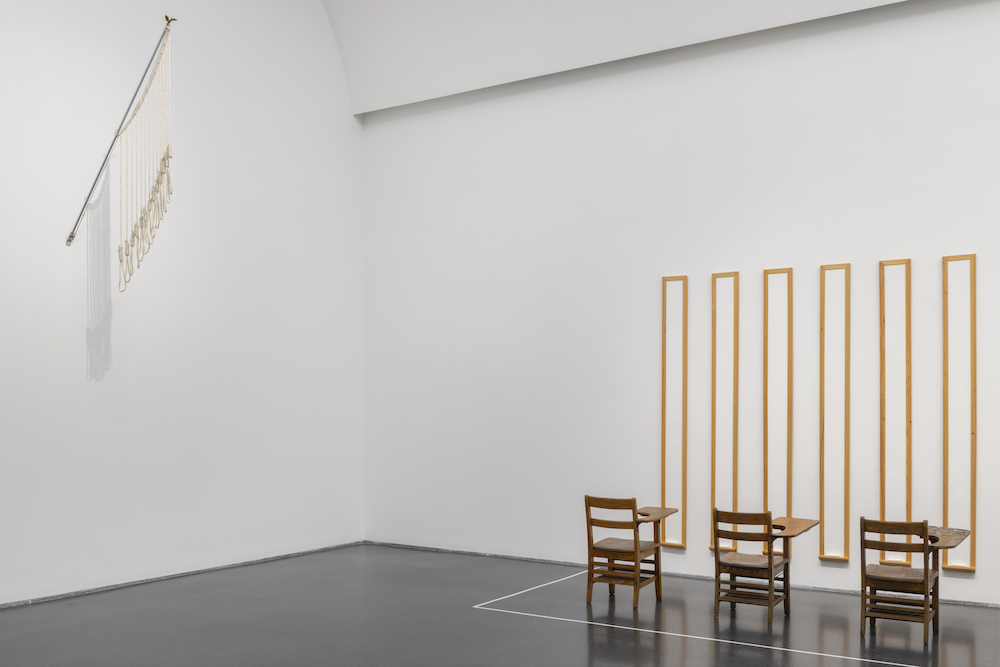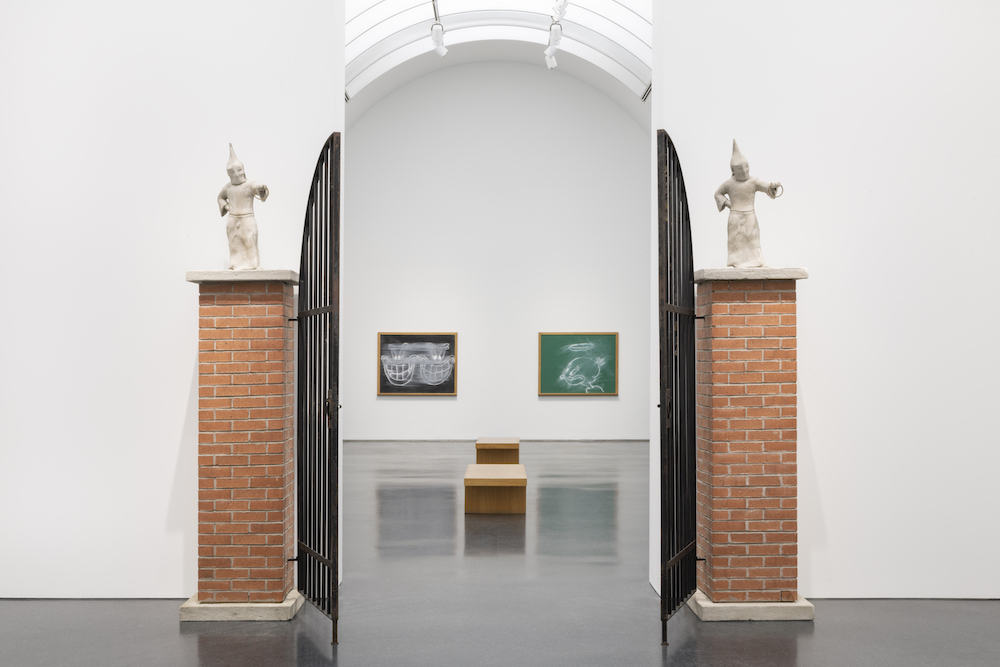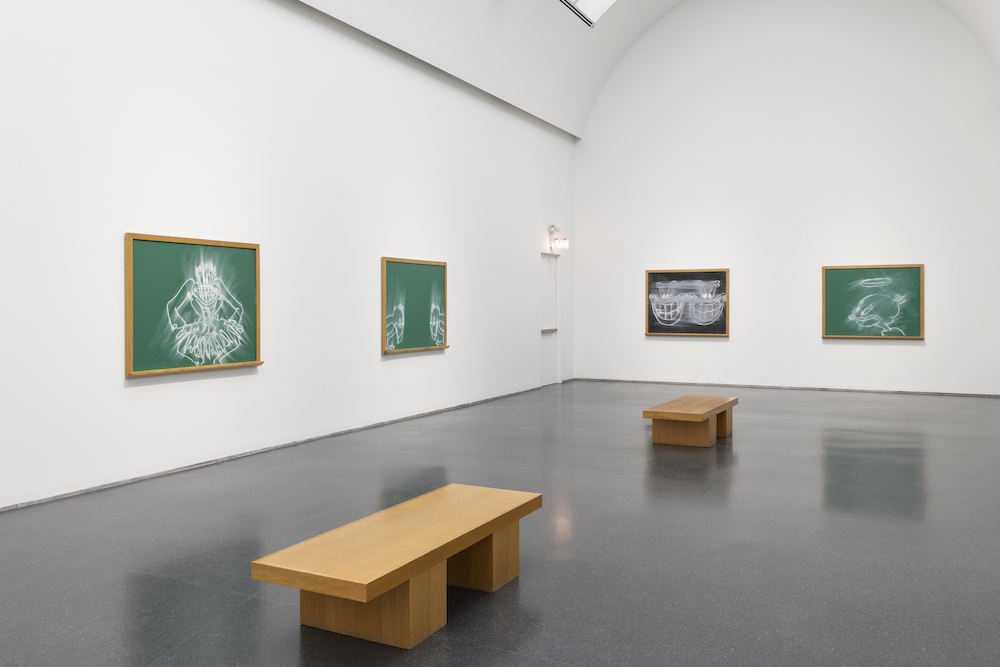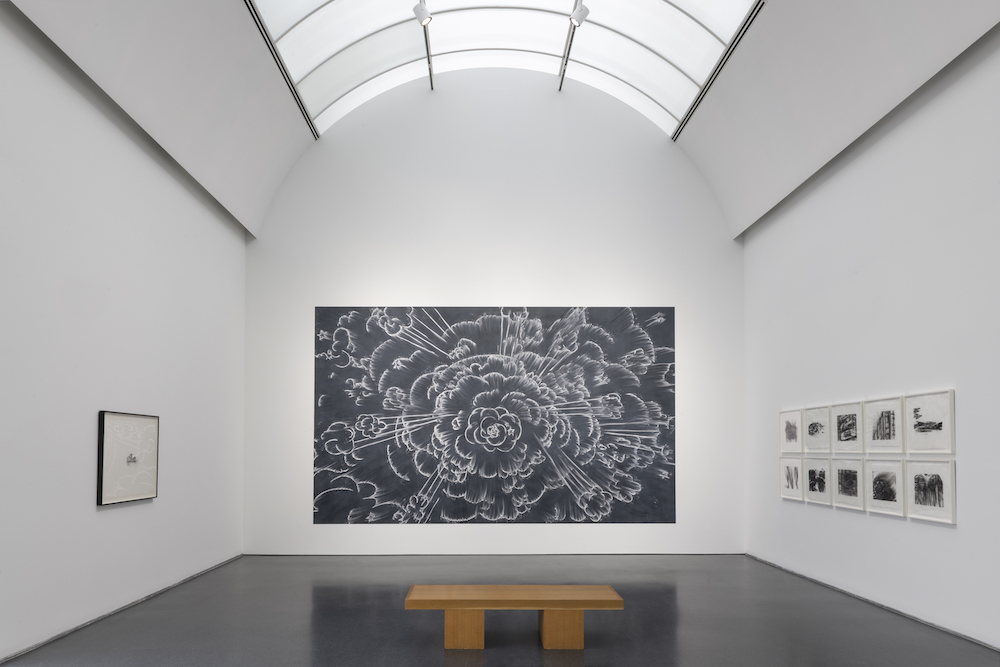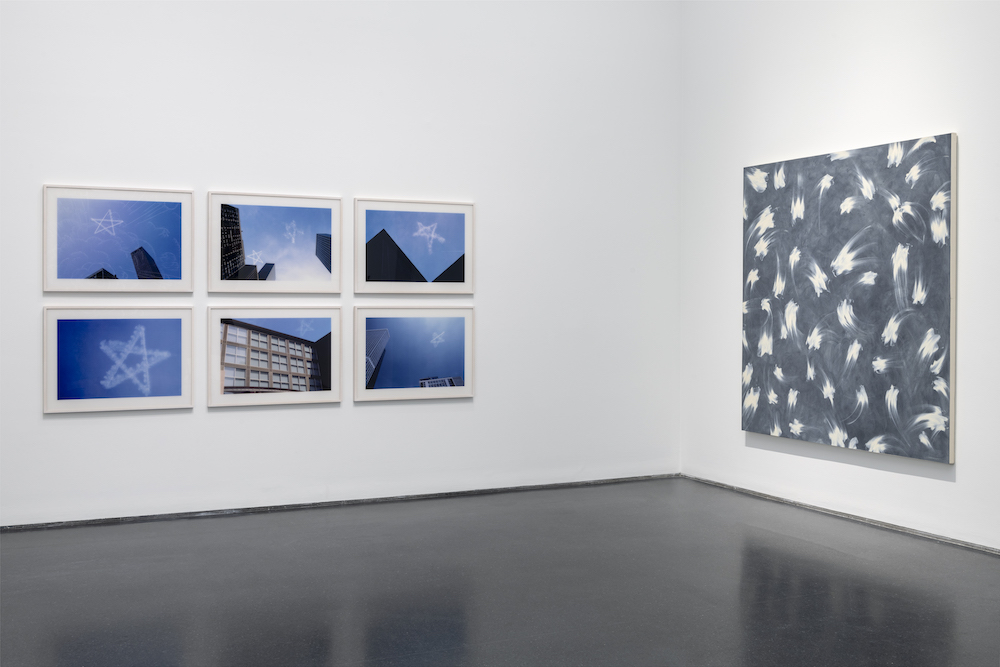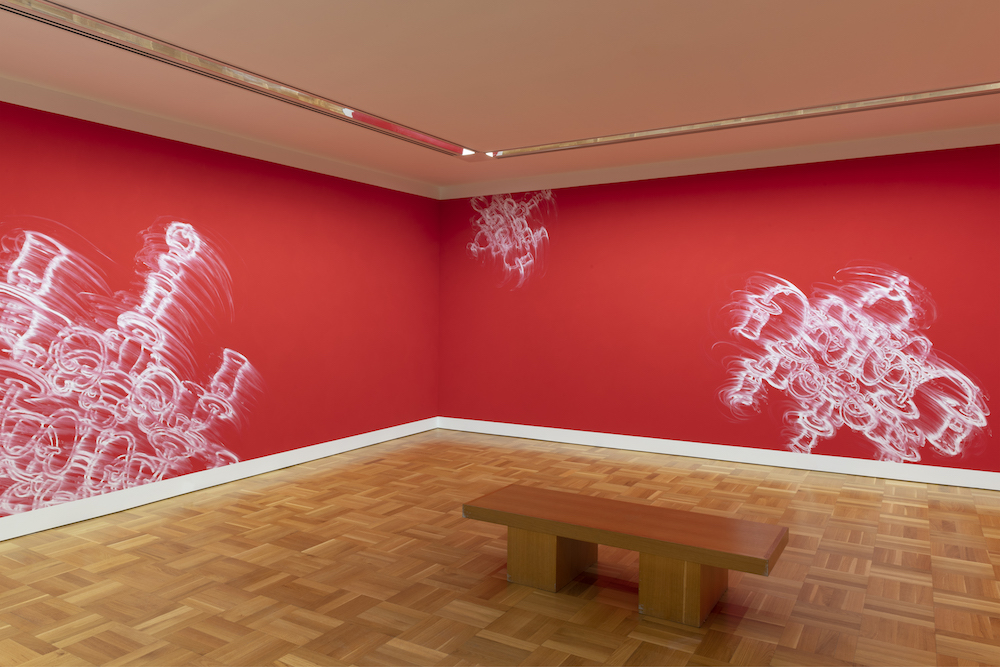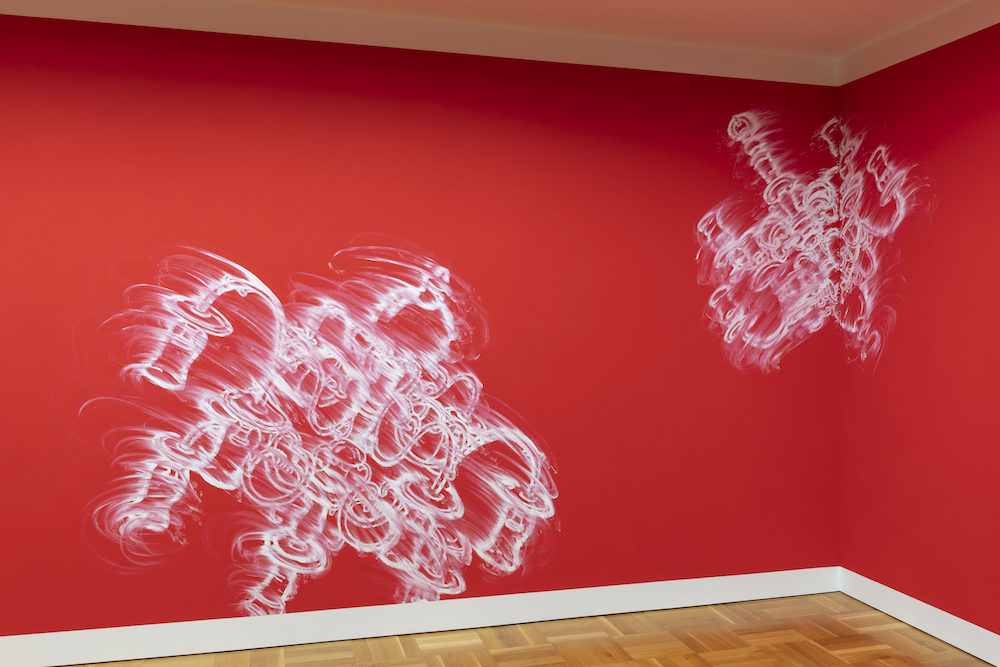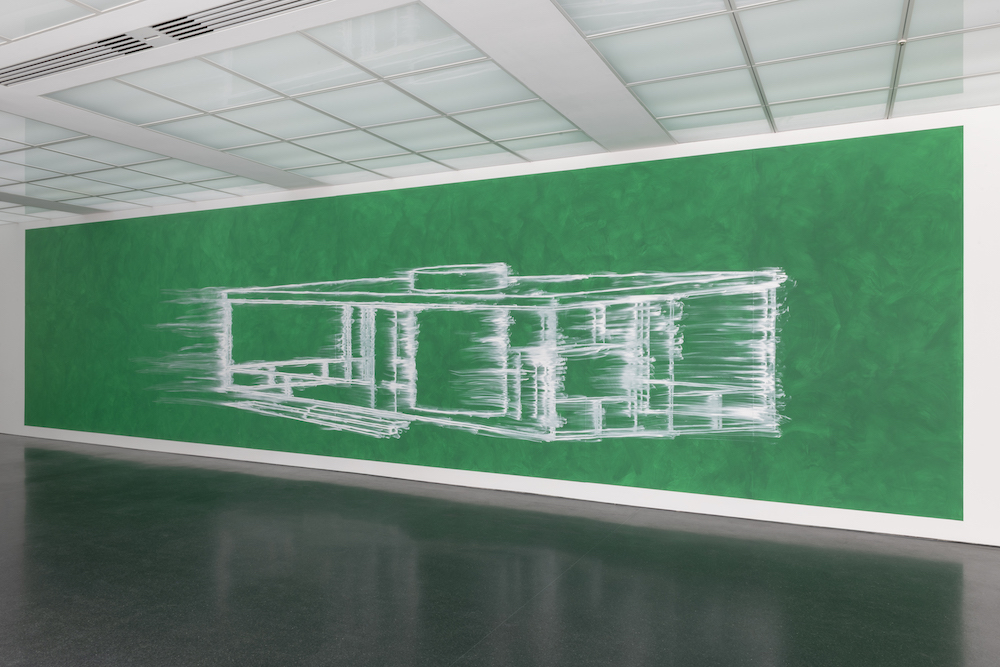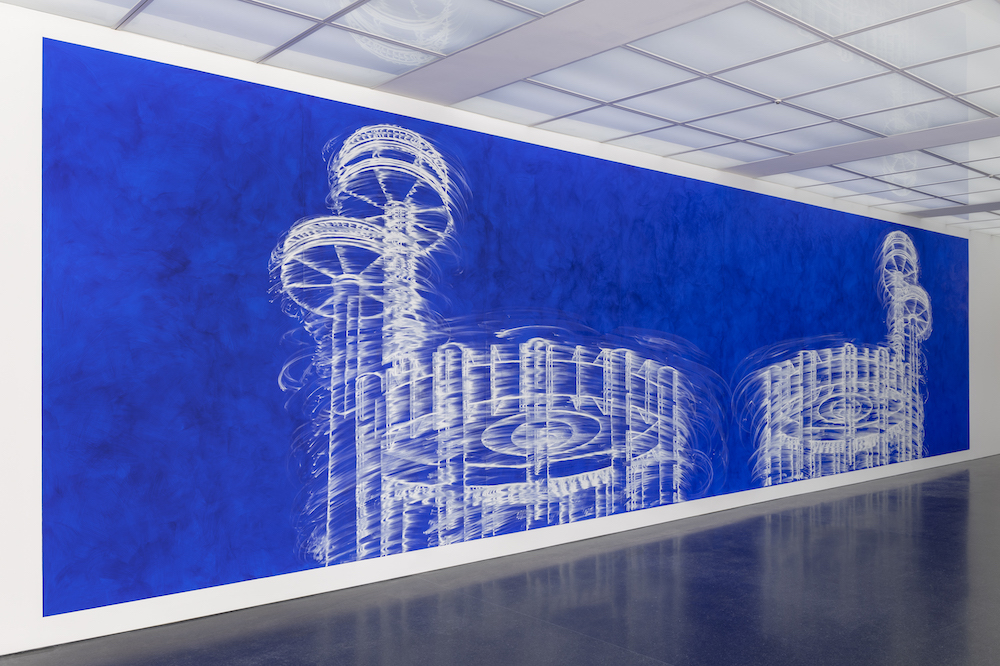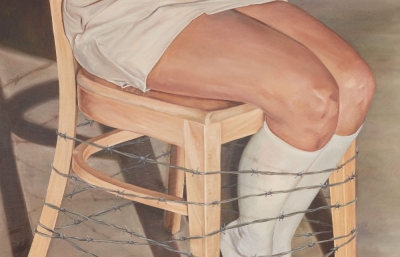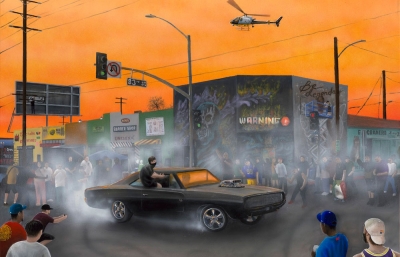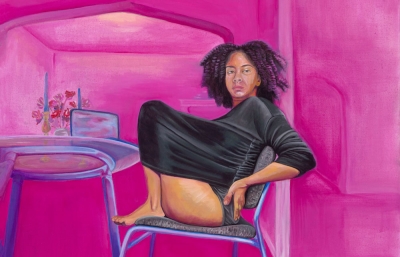Gary Simmons might best be known for his ability to conjure. Since the late 1980s, Simmons' conceptual works have investigated race, class, and gender identity, pulling the sheets off of ghosts for everyone to see. From solemn classrooms that evoke white complicity in our education system, to the gold plated Nikes that underscore systemic violence at the base of a police lineup, to his iconic blurred paintings and chalk drawings that illuminate racism within American media, Simmons' acute sixth sense confronts the darkest of our memories–memories that we’re obviously and irrevocably deeply haunted by. Most people are uneasy to admit that they can see spirits, but Simmons prospers in this sight. Where there is discomfort and fear, he finds value. He is unafraid to walk into the fire, look into the shadows under the bed, or cross the edges of the treeline, resulting in artwork that will summon you there as well. And you too may find yourself pointing to one of his paintings, standing alone in a gallery, unable to shake a ghastly presence that you can’t exactly see.
Juxtapoz spoke with Simmons about the art that has inspired his decades-long career, his love of horror and its inspiration to his oeuvre, and the social issues that have brought his work full circle, all on view at the Museum of Contemporary Art Chicago.
Shaquille Heath: Congratulations on your exhibition! This is an incredible comprehensive survey of your career. The curators have talked about all of the time that it's taken to bring this to fruition. How do you feel now that it's complete and seeing your work from the past 30 years all together?
Gary Simmons: Thank you! Yeah, the show was in process for such a long time. It was before the pandemic that we decided to do it. It's taken so many turns. You know, pieces that were in and bumped, and so on and so on. And wondering if the show would even happen… At a certain point we thought we should move it back to 2025 or 26 because all of the museum shows got backed up once the pandemic set in. So, yeah, it's been a long and windy road. It's amazing to actually see it on walls, and have that kind of response and reaction to the work. It’s been fantastic. Personally, it's always very strange to put together anything where you're going over a period of time. So much has transpired and happened socially over all that time. I like to compare it to almost like raising one of your kids and then they go off to college, and then get in relationships or whatever, and they come back to visit. And that's kind of what it's like to see some older pieces. They're attached to you, but they have a life outside of you.
That’s a great way to think about it. And you’re right, there has been so much that has happened socially since the inception of the exhibition. I imagine that was a big factor, planning the show before 2020, and seeing all of the events unfold that year that are almost repetitious of the themes that your work explored 30 years ago. And yet here we are.
Yeah, one would hope. You know, in some ways it's the same, old same old. When I made that work originally, there were so many events that took place that really kind of ignited a lot of the ideas for that work. Even music was so politically driven–from punk and reggae to hip hop and even dance music, you know, it was more politicized in a certain kind of way. I was in New York and witnessed a whole lot of horrible things that happened back in the 70s and 80s. And you draw on that as material that you're sort of fighting against, and then speed forward 30 years and boom, we're right back where we were before. Some things just never seem to change. It's those kinds of relationships… race issues, social class issues. We live with those legacies as people of color.
Going back to what you were saying about music, the title of the exhibition is Public Enemy, hearkening to a variety of things, including the 80s hip hop group. It's obvious, at least to me, that within the show Black males are public enemy number one, but what I love about your work is that so much of it is this double entendre, or even a quadruple entendre. Which makes it fun as a viewer because there's so much discovery that gets to happen. But as you're also examining whiteness, I wondered if you're making the case for who the Public Enemy actually should be?
You know, I like to leave that door open. It's almost like, throw a stack of cards on the table and see who picks up which. The voice of women and queer culture has advanced so far in that 30 year period. There are female voices that can easily plug into that public enemy kind of moniker. I think that when we think about everything from Rodney King to Yusuf Hawkins, right up to Trayvon Martin and everybody else that has become victims since then… Black males have targets on their back–always have and always will, unfortunately. It's one of those things where you have to have that talk with your daughter or your son before they leave the house. If you have this kind of confrontation, this is how you conduct yourself and this is how you hopefully stay alive. So I think a lot of those issues become like, “Who is the enemy?” At the same time, the question remains, is the enemy actually the Black male or white authority figures? So there are a lot of layers and a lot of balls in the air as to who that could be. So I try not to anchor the work to one read exclusively.
Yeah there's a centering of life and horror in your work, and you underscore Black people being a part of it since the inception of horror as a genre–whether that's been obvious to the viewer or not. I'm sure it’s interesting for a lot of people who haven’t had these realizations about old horror movies and the monsters who often act as stand-ins for Blackness. What about horror has implored you to investigate it through your work?
I've always been a fan of horror and sci fi, for myriad reasons. From a very early age, I always loved the jumpscare and being afraid in a movie and having that kind of visceral reaction to something that you see on the screen. As I got a little older, I started to really deconstruct what I was looking at and what those standards really are. And how science fiction and horror, as a whole, is this way of talking about otherness–and fear of otherness, that allows for very open conversations. That if it was directly race, class, gender issues, per se, I think they would be almost dismissed easier by the “so-called masses”.
I think that when you open that door to a sense of otherness, like say, the Planet of the Apes–I was obsessed with that film from the time I was very little. Talking about the greatest fear of all, is society being turned on its head and the minority, actually the enslaved minority, taking over. And there's this point of retribution, and even empathy towards somebody that is the colonizer. There's this great scene in Conquest for the Planet of the Apes, which mirrors a kind of Black Panther uprise in the late 60s. The lead ape is Caesar and he says to paraphrase “Now we will put down our weapons... And who were our masters are now our servants.” Essentially what he's saying is the fight stops now. And now we have to show some kind of empathy towards those that have enslaved us. And it's a very hard hitting scene that's through this filter of science fiction. It's fucking brilliant. I just love the way race and class is discussed through that series of films. I also think, you know, a film series like Alien. Even those movies in the mid 50s, like The Blob where they're screaming, and there's like this giant frog that’s superimposed over them. They look so ridiculous now, but it's this notion of otherness that was explored. And the use of fear.
That's why I'm so drawn to, and I keep going back to sci fi and horror as those kinds of films. You look at something like Night of the Living Dead, which is probably the most classic of all horror movies from that period. And there it is, one of the main roles is occupied by a Black man. There's all these white folks that are completely fearful of him holding a gun. At the end of the movie, he gets gunned down by these, you know, kind of country white folks that shoot him assuming that he's one of the deadly others.
Yeah back in 2020, I had written this essay right after George Floyd had died, and it was called “Black People are Struggling to Forgive You” about the repentance of white people at that time. And the considerations of what was needed, or if it was even possible, to forgive. I’ve been thinking about a work of yours Law of the Jungle, where you're exploring Black film history. The MCA is such a perfect space for it. You walk into the gallery and you can see Hattie McDaniels name in your blurring technique at the very end of the long hallway. Meanwhile you're in this bright white sterile room, like you’ve awakened in the hospital of 28 Days Later or Resident Evil, and the name looks just like the film credits of a horror movie.
Yeah, very much so. I think we laid it out with that in mind. René (the curator), always referred to that as the “film room,” and he really wanted that long vista of both objects and paintings and drawings that had this “end credit.”
It's interesting what you said, about “are we ready to forgive?” It's a beautiful question with two sides to that sword. I remember growing up and listening to my father, who attended a lot of you Nation of Islam and secret meetings where they would meet on one corner and then they'd be given a card to go to another location. And he would talk about the two camps. You had the followers of Dr. King and then you had the followers of Malcolm. There was a group that was willing to turn the other cheek and there was another group that was just like, no, I don't get down with that. I think the immediate response is to be in one camp, and after sitting with it and thinking about it, he joined another camp. So he straddled both. I think that that's something that we all sort of have within us as Black folks is we're always put in this position of where we have to accommodate our apologizer. Accept other failures…and at what expense? And at the same time, you know, you can only fight back for so long. You can only stay angry for so long. I guess, you don't throw up your hands and just say “Well, that's the way it is,” and move along. You try to push things forward.
But that’s the thing, it’s hard to forget. And your work holds that question, and brings so many of these ghosts to the fore of our consciousness. Your objects almost feel like they're talismans. You know, they can evoke or they can guide us. In some ways they protect us and sometimes even cause harm. Do you kind of consider that in the creation of the work?
Um, a little bit. It's difficult because you create in a very immediate, intuitive sort of way. It's almost like, this thing has to happen. And you rely on the fact of all these ingredients, so to speak, that go into making that thing. You have to trust yourself in your decision making. I don't think he can be strategic. I think you have to rely on some of those approaches and attitudes and responses to certain issues, if that's how you're choosing to make work.
Sometimes things that aren't that comfortable need to be dealt with on a surface. I think that it’s not all pleasant portraits of the culture. You know, I think that we're made up of a lot more than just that, and I think that's necessary. I think that kind of portraiture is very unnecessary. And I applaud people that do that. I look to somebody like Amy Sherald and she does incredible, incredible paintings. Or Kerry James Marshall. Those are some really great painters. But that's not my particular style. You know, I think that I like to deal with the issues of uncomfortable. The notion of uncomfortable things that take you into a different set of emotions. Anger and fear and those dark corners that define who we are. People like to push them into those dark corners and not address them. And I don't think you can get past something until you’ve addressed it. It's not about creating answers. I think it's more about creating questions that different people from all walks can grapple with. It's not just exclusively for Black folks to deal with. I think it is for white folks to deal with it. And everybody else has to be confronted by those kinds of issues. That's why I try to find or leave avenues of access for people to experience those things on their own terms–wherever they come from. Whether it's a gender specific direction or a race specific direction. In my case in the West Indies, I think class is far more hurtful and painful. So there's points of access that I think people can get in there and move around on their own terms, and sort it out for themselves.
I've got one last question for you. What's your favorite Public Enemy song?
Oh, wow. That's a very tough question. Ahh… probably Miuzi Weighs a Ton. There's so many.
You know, I think Uzi is just such a hard hitting song. The first time I heard it I was on a dance floor, and it literally stopped everybody. Just the way that song is put together is almost perfect. It's a driving beat that you could take out the vocals and everybody still knows that song. Terminator X just crushes that. That sampling and the production is off the chain. So I would have to go with that.
Gary Simmons: Public Enemy is on view at MCA Chicago through October 1, 2023.

